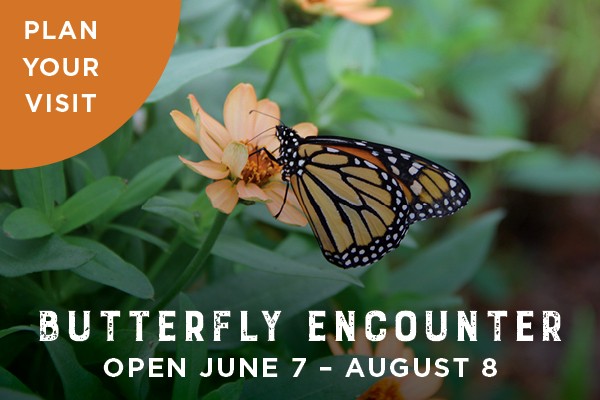Spring is in full swing, and it’s on the wing!
Explore the migration of birds and insects
By Rebekah Dolan, Visitor Services Associate
With the return of longer hours of sunlight and warmer weather, you are probably seeing many critters flying and buzzing around – some of which you may have not seen before. Each spring, thousands of birds and insects migrate north to reach their summer breeding and feeding grounds and then return south again in the fall.
Bird Migration
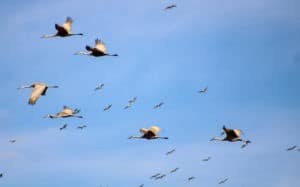
For hundreds of years, the seasonal migration of birds was largely a mystery. Did you know that the Ancient Greeks believed that birds hibernated underground? This is how they explained their disappearance in the winter, and return again in the spring.
While we have learned a lot about birds and their migration since the Ancient Greeks, much of it still seems mysterious.
Fun Facts:
- Around 4,000 species of birds are migrants. Even birds that don’t fly, like emus and penguins, still migrate by foot or swim.
- The arctic tern has the longest migration of any bird, traveling around 49,700 miles each year almost equal to traveling around the Earth twice!
- Many birds migrate at night to avoid predators and reduce the risk of overheating.
- Bar-headed geese migrate at the highest altitudes reaching heights of around 23,000 feet when flying over the Himalayas in India.
Insect Migration
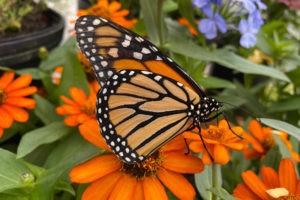
There are several species of insects that also migrate up to thousands of miles each year. The most well-known insect migrant is the monarch butterfly. Monarch butterflies are one of only a few butterfly species known to make a two-way migration like birds. While the monarch might be the most famous of migrating butterflies, the painted lady, question mark, and common buckeye also make a two-way migration. These butterflies all play an important role during their migration in pollinating crops and wildflowers.
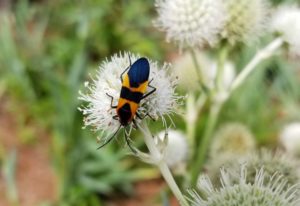
Butterflies are not the only insects that migrate. Moths, dragonflies, beetles, grasshoppers, milkweed bugs, and some species of flies also undergo long journeys in search of food and warmer weather. Besides carrying pollen, because insects themselves are food for birds and other animals, their annual migrations are very important for ecosystems.
Fun Facts:
- Milkweed bugs, just like monarch butterflies, are colored orange and black to warn off predators and migrate following the emergence of milkweed plants in the spring and summer.
- The wandering glider, a species of dragonfly, undertakes the longest migration traveling more than 4,350 miles one way. In the Eastern Hemisphere, they are known to migrate from India to Africa by crossing the Indian Ocean and are the only known insect to make a transoceanic crossing.
- The hummingbird hawk-moth resembles a hummingbird as it flies between plants and hovers over flowers. Like, butterflies, hawk-moths also migrate, but they generally migrate at night, as opposed to butterflies which migrate during the day.
- Hoverflies mimic stinging insects like wasps with stripes and bright colors and migrate over multiple generations. As they do so, their larvae eat trillions of aphids, and the adults visit billions of flowers carrying pollen as they go, making them the ultimate gardener’s friend!
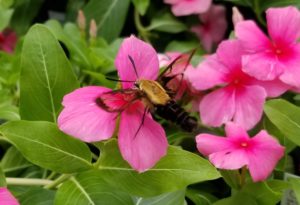
The annual migrations can be really exciting to watch, they are also a very dangerous time for birds and insects. Some dangers may come from predators, but a lot can be caused by humans.
Each year, millions of birds die from building collisions, and pesticides can cause the deaths of billions of beneficial insects.
What Actions can you Take During Migration Time?
- Make your windows bird-friendly. Placing decals on your windows that reflect ultraviolet light can help prevent collisions. Also, something as simple as turning out the lights at night can help keep migrating birds safe.
- Make your yard a haven for wildlife by growing native plants. Not only do native plants provide perfect hosts for insect larvae, including butterflies, but the larvae and insects the plants attract also provide food for birds, lizards, toads, and other insects like dragonflies.
- Eliminate pesticides from your yard. Even pesticides that do not harm birds directly can pollute water sources and kill beneficial insects as well as insects that birds rely on for food.
- Keep your cat indoors. Cats can cause many bird deaths, so keeping kitty indoors helps keep birds safe, especially when young birds are beginning to leave the nest.
- Join bird and insect conservation groups and citizen science projects. The more we learn and know about the world around us, the more we will care. The more we care, the harder we will strive to protect. Check out the Urban Kings Project and Atlanta Firefly Project for citizen science projects in the metro Atlanta area.
Migrate to the Chattahoochee Nature Center this summer to visit the Butterfly Encounter opening in June. Learn about amazing native butterflies, their importance to our planet, and their incredible migration journey. As a bonus, you can buy native, pollinator-friendly plants outside the Butterfly Encounter to make your home a paradise for migrating wildlife.

